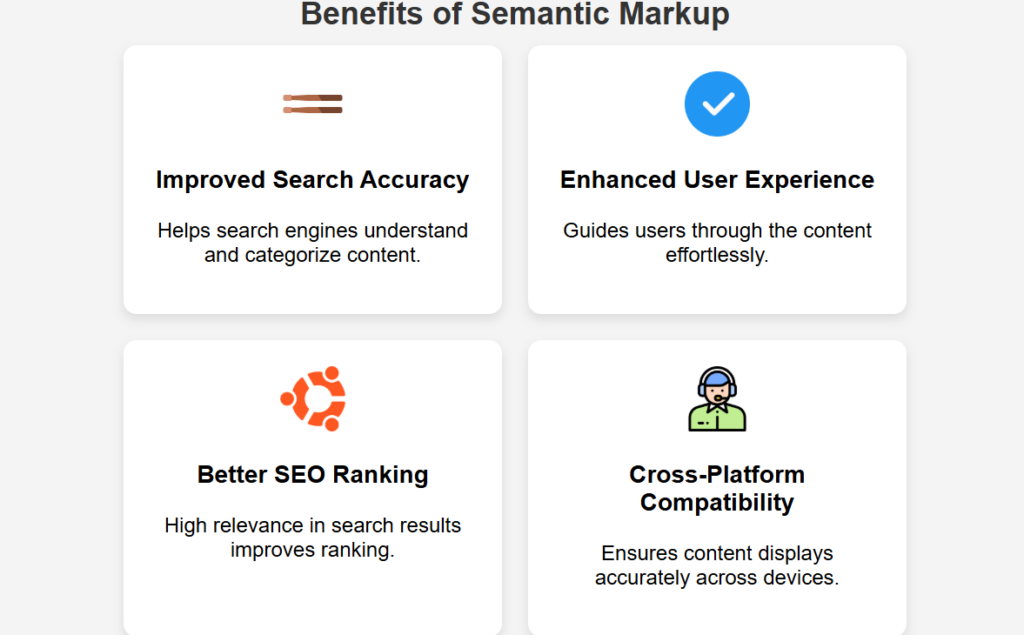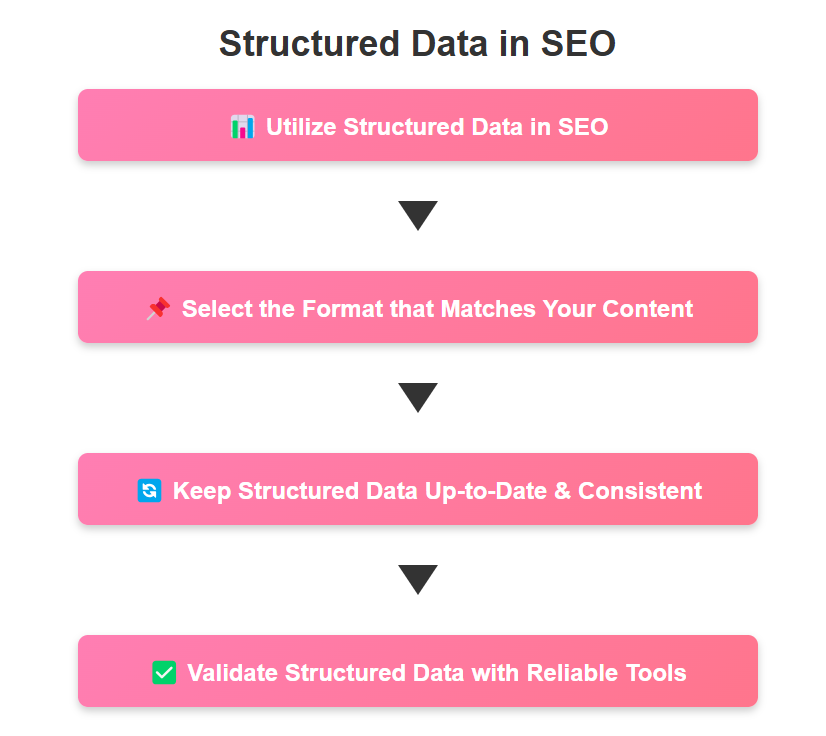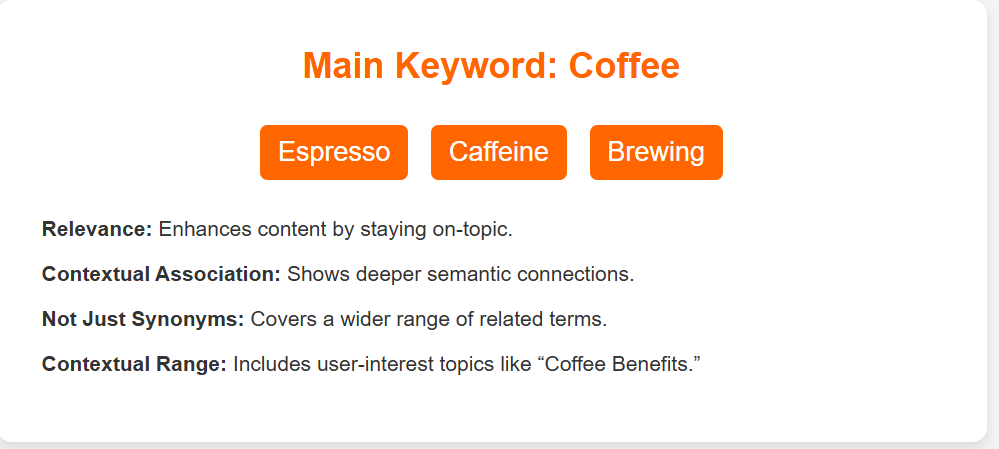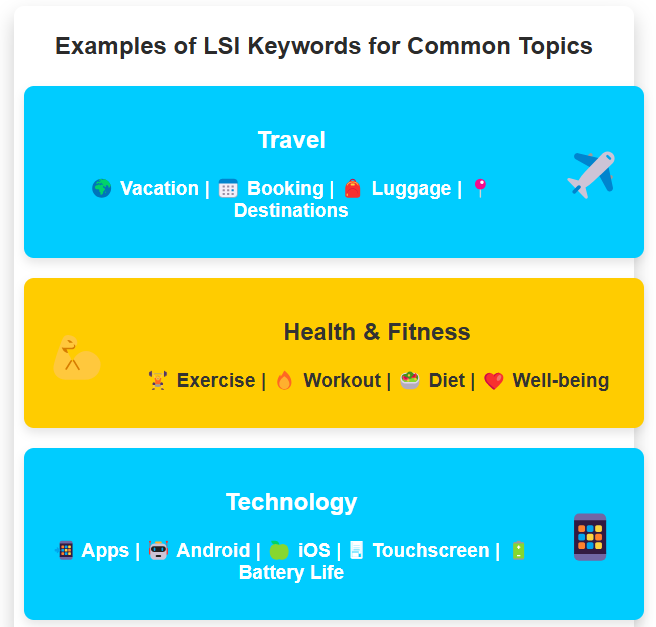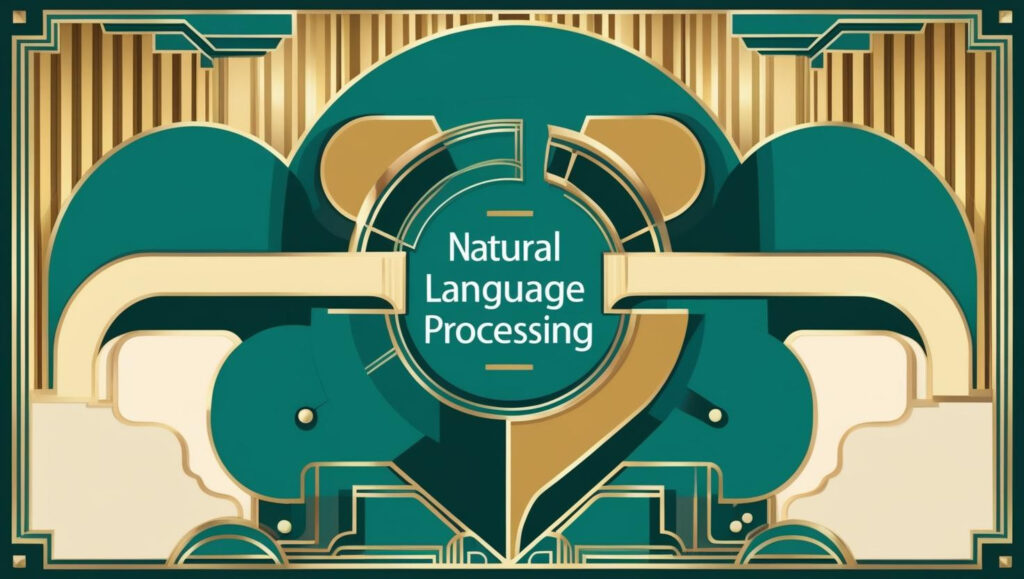In today’s digital age, understanding search intent is not just beneficial—it’s essential. Research indicates that 70% of all online experiences begin with a search engine. This emphasizes the importance of knowing what your audience truly seeks.
People don’t search for just keywords; they search for answers.
This quote highlights the need to comprehend user intent for effective content creation.
Aligning your content with search intent can dramatically improve your organic traffic and engagement. In this comprehensive guide, we’ll explore the various dimensions of search intent and its significance in SEO. We’ll provide actionable insights to enhance your strategy and ultimately meet your audience’s needs more effectively.
Let’s dive into the world of search intent and unlock its potential for your business success.
The Essence of Search Intent in SEO
At the heart of search engine optimization (SEO), understanding search intent is pivotal. It’s the bridge between what users are searching for and how you can satisfy that need. This connection is what makes search intent a game-changer in your semantic SEO strategy.
SEO is not just about keywords. It’s about understanding why someone is searching for something. Recognizing this ‘why’ is the key to delivering the most relevant content. Hence, aligning your SEO with search intent ensures you provide value to your audience. This alignment helps you drive organic traffic more effectively.
However, adapting to search intent involves more than tweaking keywords. It requires analyzing user behavior and adjusting strategies accordingly. By observing how users engage with search engines, you can tailor content to meet their expectations. Therefore, integrating search intent into your SEO efforts is a strategic necessity.
To thrive, businesses must recognize the dynamic nature of search intent. Search trends shift as user preferences and technology evolve. Staying in tune with these shifts ensures that your content remains relevant over time.
In essence, mastering search intent in SEO requires continual learning and adjustment. This adaptability allows businesses to maintain strong visibility in search engine results. Now, let’s dive deeper into the specific definition of search intent.
Defining Search Intent
Search intent, at its core, refers to the purpose behind a user’s query. It’s the underlying reason for using a search engine. This concept is crucial because it guides how search engines deliver results.
When users search, they typically have specific objectives in mind. They might want to find information or make a purchase. Understanding this intent is vital for tailoring content to meet user needs.
There are various forms of search intent, each with unique attributes. Some users are just gathering data, while others are ready to buy. By identifying the intent, you can tailor your content strategy accordingly.
Thus, defining search intent is more than just categorization. It involves recognizing user motivations and aligning your content to satisfy those needs. This alignment significantly influences your site’s ability to attract and retain visitors.
Why Search Intent Matters for Your Business
For any business aiming to improve its online presence, understanding search intent is essential. It informs how you structure your digital content and marketing strategies. A strong grasp of search intent can set your business apart in a crowded market.
Firstly, aligning your content with user intent helps in attracting qualified traffic. Instead of random site visits, you attract visitors who are genuinely interested in what you offer. This targeted approach results in better engagement and higher conversion rates.
Moreover, search intent plays a critical role in content relevancy. Google prioritizes content that best meets the user’s query intent. If your website consistently aligns with this intent, it stands a better chance of ranking higher.
Another advantage is enhanced user experience. When you understand what users are looking for, you craft content that directly addresses their needs. This clarity boosts user satisfaction and encourages repeat visits.
Lastly, understanding search intent aids in refining your advertising efforts. By tapping into user intentions, you can create more effective pay-per-click (PPC) campaigns. These campaigns are more likely to resonate with potential customers and drive sales.
In summary, focusing on search intent is not optional for growing businesses. It is a strategic approach that significantly impacts visibility and profitability. Embracing search intent as a central part of your business strategy is crucial for success in the digital landscape.
Unraveling the Four Main Types of Search Intent
Search intent can be categorized into four main types: informational, navigational, transactional, and commercial investigation. Each type reflects a different stage in the user’s journey. Understanding these categories allows you to tailor your content precisely to what users want.
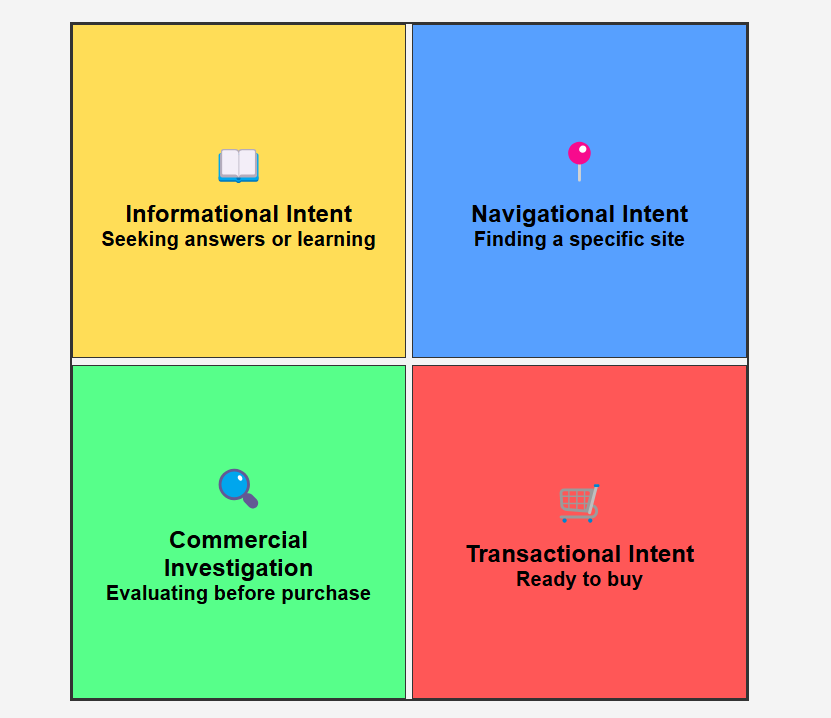
- Informational Intent: Users seek answers or learn about a topic.
- Navigational Intent: Users aim to find a specific site or page.
- Transactional Intent: Users intend to make a purchase or engage with a service.
- Commercial Investigation: Users evaluate products before purchasing.
Recognizing these types helps you create content that meets specific user needs. For instance, if a user has an informational intent, the content should be educational and thorough. On the other hand, if the intent is transactional, a clear call to action is crucial.
Properly aligning your content with these types enhances user satisfaction. It also boosts your content’s effectiveness in achieving desired marketing results. Let’s delve into each type to understand them better.
Informational Intent: Seeking Knowledge
Users with informational intent are in search of information. They want to learn something new or get answers to questions. These queries often take the form of “how-to” guides or specific topic questions.
Content catering to informational intent should be detailed and valuable. Providing clear answers and comprehensive insights fulfills the user’s search needs. As a result, well-aligned content can boost your brand’s authority and trustworthiness.
Navigational Intent: Finding a Destination
When a user exhibits navigational intent, they are searching for a specific webpage. These searches often include brand or website names. Users already have a destination in mind, and your task is to ensure they find it.
Optimizing your site for navigational searches involves clear branding and SEO for your company’s name. This ensures your site appears prominently when users specifically seek it out. Meeting navigational intent seamlessly enhances user convenience.
Transactional Intent: Ready to Purchase
Transactional intent signifies that a user is ready to make a purchase. They might be looking for product availability, pricing, or a purchase page. Your role is to facilitate this transaction smoothly.
For transactional intent, pages should be optimized with clear CTAs and easy-to-navigate sales funnels. This encourages users to complete their purchase swiftly. Ensuring a seamless purchase experience is key to converting these users.
Commercial Investigation: Deciding to Buy
Users in the commercial investigation phase are evaluating products or services. They seek comparisons, reviews, and detailed product information. They’re almost ready to buy, but they need more convincing.
Content for commercial investigation should include detailed comparisons and compelling reviews. Providing credible information helps users make informed decisions. Addressing this intent effectively can guide users to finalize their purchasing decision.
Overall, recognizing and optimizing for these types of search intent significantly enhances your SEO strategy. This focus aligns your content with user needs, improving both engagement and conversion rates.
Identifying Search Intent: Practical Strategies and Tools
To fully capitalize on search intent, you need to identify what users are seeking effectively. Understanding this helps create content that resonates with your audience. The process begins with keyword research and a few strategic tools.
By analyzing keywords, you uncover the intent behind search queries. Determine whether users seek information, navigation, transactions, or comparisons. This insight guides the content creation process to align with user needs.
Several practical strategies can enhance this understanding:

- Keyword Analysis: Determine the predominant search intent.
- SERP Examination: Analyze search results to infer intent.
- User Behavior Tracking: Understand how users interact with content.
These methods reveal how users engage with your niche. Additionally, tools like Google’s Keyword Planner help to discern user intent more accurately. Using this data, create tailored content strategies that address specific user needs.
Crafting intent-aligned content involves more than general keyword placement. It requires understanding the context and purpose of user searches. This emphasis on context significantly boosts content relevance and engagement rates.
Analyzing Keywords for Intent
Keywords are the cornerstone of understanding search intent. Each keyword indicates a different user need or query. It’s crucial to dissect these keywords to unveil their underlying intent.
For instance, keywords like “buy” or “price” often signal transactional intent. Conversely, “how to” or “benefits of” typically indicate informational intent. Categorizing keywords by intent type enables targeted content planning.
Keyword analysis also involves assessing search volume and competition. High search volume combined with low competition indicates fertile ground for content creation. Aligning your content with these insights maximizes SEO effectiveness.
Leveraging Search Intent Tools
Search intent tools offer invaluable support in identifying user needs. These tools harness data to predict and analyze user behavior more accurately. They provide a deeper understanding of the search landscape.
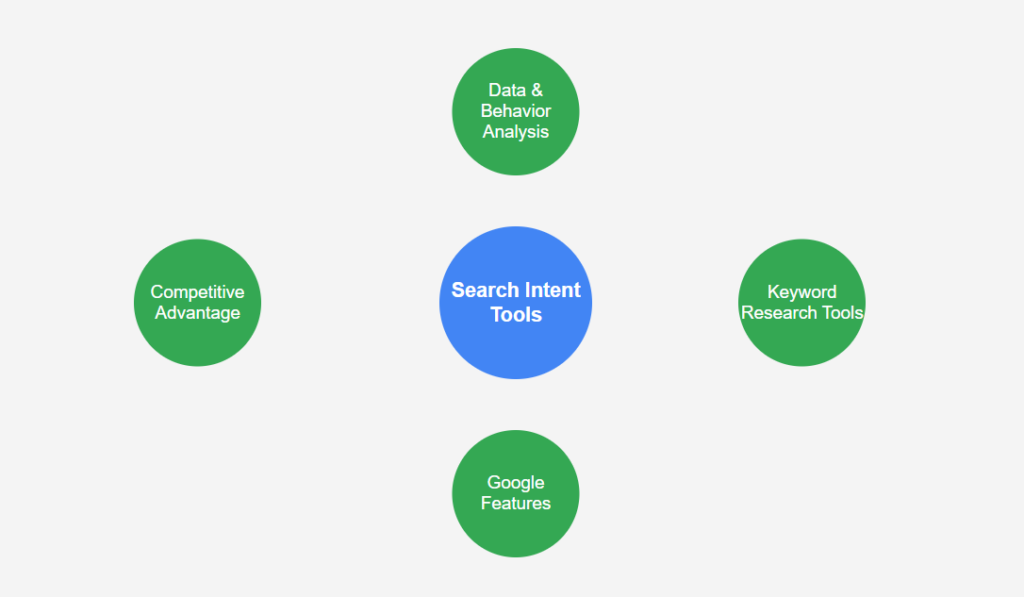
Tools such as SEMrush and Ahrefs provide in-depth keyword analysis. They offer insights into search volume, trends, and competitive landscape. This data is crucial for refining SEO strategies and content planning.
Moreover, Google’s autocomplete and “People also ask” sections are practical tools for understanding search behavior. These features give real-time insights into common user queries. Leveraging these tools ensures your content addresses genuine user concerns effectively.
Intent tools are instrumental for staying ahead in the competitive digital arena. They help fine-tune your SEO approach, ensuring content relevancy and audience engagement. Adapting to these insights is key to thriving online.
Crafting Content That Aligns with Search Intent
Aligning content with search intent is pivotal for engaging and retaining your audience. Tailoring your content to meet specific intents ensures it resonates more effectively with users.
Start by categorizing your content based on user intent. Each type of search intent demands a different content strategy. Whether it’s informational, navigational, transactional, or commercial investigation, understanding these nuances is key.
Ensure your content is actionable and informative for informational intent. For navigational intent, your content should provide clear pathways and guidance. Transactional content should focus on conversion opportunities, while content for commercial investigation should aid decision-making.
Your content structure should incorporate these elements seamlessly. This approach not only boosts engagement but improves search engine rankings. Think about clarity and immediacy when presenting information to users.
Here’s how to make sure your content aligns:
- Informational Content: Focus on clarity and depth.
- Navigational Pages: Provide clear paths and menus.
- Transactional Queries: Highlight conversion opportunities.
- Commercial Investigation: Offer thorough comparisons and reviews.
Using these strategies, you ensure your content meets user expectations at every search stage. This alignment also helps drive traffic, improve dwell time, and reduce bounce rates. Balance your keyword strategy with these intent-driven nuances for optimized content delivery.
Tips for Informational Content
Informational content should aim to educate and offer value. Your goal is to position your content as a trusted resource. Start with in-depth research and understand the pain points of your audience.
Structure your content logically, employing headers and lists. Use clear, simple language to ensure readability and comprehension. Incorporate multimedia elements like videos or infographics for enhanced engagement. These elements help break down complex topics, keeping users engaged longer.
Best Practices for Navigational Pages
Navigational content should guide the user efficiently. Clarity and simplicity are paramount in designing these pages. Begin by ensuring your site navigation is intuitive and user-friendly.
Use clear labels and pathways to help users find their desired destination quickly. Implementing a search bar and optimizing for local SEO are essential for enhancing usability. These efforts can reduce frustration and improve user satisfaction, leading to positive engagement.
Optimizing for Transactional Queries
Transactional content should be conversion-focused. Your primary aim is to persuade users to take action. Highlight product benefits and unique selling propositions.
Use strong calls-to-action (CTAs) to encourage purchases or subscriptions. Offering testimonials and reviews builds trust and persuades hesitant buyers. Make checkout processes seamless and secure to enhance user experience and boost conversion rates.
Addressing Commercial Investigation Needs
Content for commercial intent should aid in decision-making. Offer detailed comparisons between products or services. Inform users without bias, presenting both pros and cons. This transparency builds credibility and assists users in making informed choices.
Measuring the Impact of Search Intent Optimization
Understanding search intent is just the start. Measuring the impact of your optimizations determines success. Essential metrics provide insights into how users interact with your content.
Begin with user engagement metrics. Measure click-through rates (CTR) and conversions. Low CTR might indicate misaligned content or irrelevant keywords. Conversions indicate the effectiveness of your call-to-action.
Utilize web analytics tools to gather these metrics efficiently. Regular monitoring helps pinpoint areas needing improvement. This data-driven approach ensures your strategies remain effective.
Consider creating a list of key performance indicators (KPIs) to track progress:
- Click-Through Rates (CTR)
- Conversion Rates
- Bounce Rates
- Dwell Time
- User Engagement
Use these KPIs to evaluate the outcome of your search intent strategies. Regular audits and analyses are crucial for ongoing optimization. Look for patterns in user behavior that can inform further adjustments.
Tracking Click-Through Rates and Conversions
Tracking CTR and conversions is vital for assessing search intent alignment. High CTR suggests that your content resonates with user queries. It also indicates effective title and meta description strategies.
Conversions tell you if users are taking desired actions. For instance, a high conversion rate often signifies that transactional content is compelling. Ensure your conversion goals align with business objectives for maximum impact.
Using Analytics to Refine SEO Strategies
Web analytics tools are invaluable for refining SEO strategies. Google Analytics, for example, provides comprehensive data on user interactions. Use this data to identify trends and areas for improvement.
Analyze bounce rates and dwell time for additional insights. High bounce rates might reveal a gap in your content’s relevance. Conversely, longer dwell times can indicate content that matches user expectations.
Leveraging analytics enables you to adjust strategies proactively. Regularly update content and keywords based on these insights. This approach ensures your SEO efforts remain aligned with user needs and search intent.
Advanced Techniques for Search Intent SEO
Advanced techniques in search intent SEO are crucial for businesses looking to get ahead. These tactics allow for a deeper understanding of user needs. Implementing these strategies can refine your SEO practices significantly.
Start with semantic SEO, which focuses on context. This technique goes beyond keywords. It considers how words relate to each other in content. Integrating semantic SEO into your strategy can enhance your content’s relevance.
Semantic SEO and User Intent
Semantic SEO enhances user experience by delivering more precise content. It understands the meaning behind user queries. By doing so, it aligns more closely with searchers’ real intentions.
This approach elevates the quality of your SEO efforts. It highlights the importance of creating valuable, context-rich content. By focusing on semantics, you cater to subtle nuances in user queries.
The Role of AI and Voice Search in Understanding Intent
Artificial Intelligence (AI) is transforming search dynamics. It processes vast amounts of data to comprehend user behavior. Tools like Google’s RankBrain provide more intuitive search results.
Voice search adds another dimension. It shifts search queries towards conversational language. This change underscores the need for natural language processing. Adapting to voice search ensures you capture a growing audience segment.
Capitalizing on Strong Intent Queries
Strong intent queries are goldmines for businesses. These are searches where the user clearly indicates an intent, such as buying. Identifying these queries allows you to focus marketing efforts.
Craft content that responds directly to these strong intent searches. Ensure your call-to-actions are clear and compelling. This targeted approach can significantly increase engagement and conversions.
Case Studies: Success Stories of Intent-Based SEO
Learning from real-world success stories can provide valuable insights into the effectiveness of intent-based SEO. These case studies highlight how businesses have effectively leveraged search intent to boost their online visibility and revenue.
One example is a small e-commerce business that targeted transactional search intent. By revamping their product pages to align with transactional queries, they saw a 30% increase in conversion rates. This shift in strategy underscored the impact of understanding the buying intent behind user searches.
Another case involves a local restaurant that focused on optimizing for navigational search intent. By ensuring their website appeared when users searched for their restaurant name or location, they boosted foot traffic by 20%. This success demonstrates how crucial it is to target users looking for specific destinations or services.
A third case study involves an educational blog that tapped into informational search intent. By creating thorough, informative articles related to user queries, they increased their organic traffic by 40%. This approach highlighted the importance of providing valuable content that meets users’ desire for knowledge.
These success stories show that understanding and leveraging search intent is a powerful tool. Businesses that adapt to user needs through search intent optimization can achieve remarkable growth and improved user engagement.
Conclusion: The Future of Search Intent and SEO
The digital landscape is evolving, and search intent is at the forefront of this change. As algorithms become more sophisticated, understanding user intent is crucial for effective SEO strategies. Businesses must stay ahead by continuously adapting to these shifts, ensuring their content aligns with evolving user needs.
The rise of voice search and AI further emphasizes the importance of interpreting search intent accurately. As users transition to more conversational searches, businesses must refine their strategies to capture this new form of intent. By doing so, they can improve their visibility and engagement in the search engine results pages.
Embracing search intent as a core component of SEO will guide businesses toward sustainable growth. Understanding user behavior and preferences helps craft content that truly resonates with your target audience. This forward-thinking approach will ensure success in the ever-changing SEO landscape.
Embracing Continuous Learning and Adaptation
In this dynamic field, continuous learning and adaptation are essential. Staying updated with the latest trends and algorithm changes is critical. By embracing new techniques and technologies, businesses can maintain a competitive edge in SEO.
Adapting strategies based on data-driven insights allows businesses to respond to user needs more effectively. Implementing changes informed by real user interactions ensures your site remains relevant and useful to its visitors. This adaptability is the key to thriving in the digital landscape.
Final Thoughts for Small Business Owners
Small business owners should prioritize understanding search intent to enhance their digital strategies. By aligning content with user needs, you open doors to increased traffic and engagement, driving long-term success.


